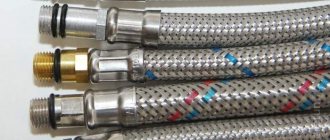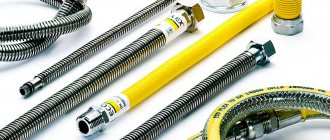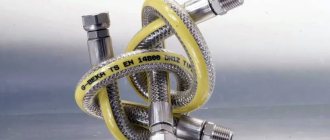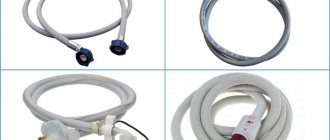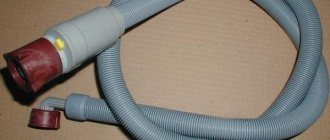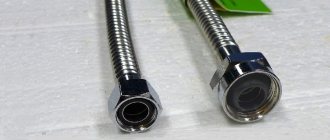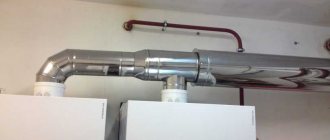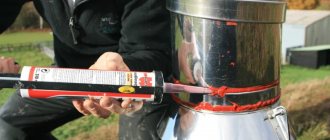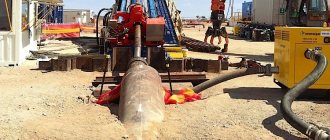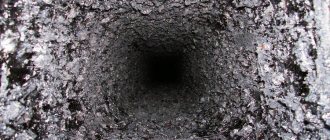To connect gas stoves in communal apartments or individual houses, flexible and elastic hoses are usually used. One of the modern and quite popular solutions is a bellows gas supply.
It is worth noting that corrugated hoses are forced to compete with different types of flexible gas hoses and have certain advantages and disadvantages in relation to them. It is useful for the consumer to know the features of flexible bellows, their types, cost and installation nuances.
Rice. 1 Plates with bellows
Installation
Connecting gas stoves using a flexible hose is carried out according to a standard scheme, which consists of the following steps: a main pipe - a riser - passes through each apartment of a gasified house. A pipe extends from the riser, called a pipe by experts, at the end of which a gas tap is installed. A gas meter is installed between the tap and the outlet, taking into account fuel consumption. The tap section size is usually 1/2, which corresponds to a diameter of 15 mm. One end of the flexible hose is screwed to the tap, making sure to treat the threaded connection with sealant.
The hose must be screwed directly to the tap; there should be no additional connections or unnecessary bends. The use of adapters is allowed only in cases of extreme necessity, when it is not possible to purchase a hose compatible with the outlets of the faucet and stove. In this case, all connections must also be well coated with sealant and, upon completion of installation, checked using soap foam.
If no soap bubbles appeared on the surface when the gas was turned on, then the installation was carried out correctly and the device can be safely used. In addition, when connecting a flexible hose, it is necessary to install paronite gaskets equipped with a metal mesh and included in the hose kit. The mesh will act as a kind of filter and protect the system from possible contamination.
After the hose is connected to the gas tap, it should be screwed to the stove. To do this, there is an inlet pipe on the rear wall of the device, which can be located either perpendicular to the rear wall of the furnace or at a slight angle relative to it. The angular location of the nozzle is more preferable, since it does not allow the hose to bend sharply and allows you to install the slab almost flush to the wall.
Quite often the inlet pipe has a 3/4 thread. In this case, it is necessary to use a fitting - a special adapter with a diameter of 1/2. The hose is connected to the furnace outlet or adapter using a union nut, which is tightened with an open-end wrench. Upon completion of installation, the connection is coated with a sealant, and after it dries, with a soap solution. Then open the gas tap and test the connection for leaks.
The above installation algorithm is purely advisory in nature, since all work on connecting the stove using a gas hose should only be carried out by a gas specialist
If for some reason you have to do the installation yourself, then you should familiarize yourself with some rules that will help you correctly connect the flexible hose, while observing all safety precautions
- It will not be possible to hide the sleeve in the floor or wall of the kitchen: it must be located in a well-accessible place and be in a free state.
- The hose must not be kinked or bent too much. The maximum permissible bending radius of the hose must be greater than the sum of its three diameters.
- Do not paint the gas hose. The paint causes the rubber to dry out excessively and can cause it to quickly crack.
- Hose connection elements and adapters are often made of different metals, which threatens electrolytic processes and damage to metal parts. To prevent such troubles, only compatible metals can be screwed: copper with brass and steel with steel.
- Over-tightening the nuts may cause them to break and require replacement of the entire hose.
- Installation of flexible hoses longer than 4.5 meters is prohibited. If the gas stove is significantly removed from the main tap, the outlet is increased using steel pipes. Any welding work to extend the “vacation” should be carried out after the house is completely disconnected from the gas supply and only by gas service specialists.
- After connecting the flexible hose, a note is made in the gas subscription book with the exact date of installation. This information will help you not miss deadlines and change your sleeve on time.
Metal bellows compensators. Purpose, composition and types
Metal bellows are thin-walled pipes, which, by giving them a corrugated shape, acquire flexibility, like a hose, and springing ability. Giving the appropriate shape makes the original rigid pipe flexible and at the same time increases its strength compared to a pipe with the same wall thickness. Under the influence of pressure, temperature, force or torque, a bellows is capable of stretching, compressing, bending or shifting, and converting pressure into force.
The bellows may consist of one or more annular corrugations - the simplest flexible elements located between adjacent depressions.
The shape of corrugations can be varied. As a rule, bellows are made with U-shaped corrugations, in justified cases - Ω-shaped, and also with the use of reinforcing (reinforcing) rings. The total compensating capacity of the bellows is proportional to the number of corrugations. The spring-loaded bellows compensate for movement without friction and are maintenance-free.
The bellows can be single-layer, made from one shell of thickness sufficient to ensure the strength and tightness of the compensator, or multi-layered from two or more shells assembled in a package (up to 20 or more layers are made).
Each type of bellows has its own advantages and scope of application. The ability to use a total wall thickness with almost any number of layers and the thickness of each layer makes the multi-layer bellows suitable for use in expansion joints operating under various conditions, including extreme ones. Thanks to the multilayer structure of the walls, greater elasticity is achieved with low bending or compression rigidity. In this case, a multi-layer bellows can be compared to a multi-layer leaf spring.
Multilayer bellows can be manufactured either by a set of welded shells in a package of the required thickness, or by making two inner and two outer layers from welded shells to ensure the tightness of the bellows, and intermediate layers by winding them into a roll to forcefully relieve the bellows from pressure.
The advantage of a multilayer bellows, as shown by many years of experience and numerous tests, is that if for some reason this element loses its tightness (corrosion, damage during installation, etc.), there is no reason to fear instant destruction of the bellows. This is especially important for systems operating under high pressure. During depressurization, which begins from the inner layer of the bellows in the form of a pore or small crack, a small amount of medium initially leaks. Thus, the location of the leak - at least until the compensator is replaced - does not pose a danger.
The total thickness of the bellows for each expansion joint, necessary to ensure its stability, is determined both by calculation and experimentally. The main parameter for determining the thickness of the bellows, along with the strength of the material, the size of the corrugations, diameter, etc. is the length of the corrugated part. The bellows, as a flexible element, with increasing length under the influence of internal pressure becomes prone to longitudinal bending, i.e., to loss of stability. This property is of particular importance for axial expansion joints, where a bellows of appropriate length is required to accommodate large axial strokes. The maximum number of bellows corrugations is determined by its ability, with appropriate geometric parameters and pressure of the conducting medium, to resist loss of stability. Bellows calculations are performed in the calculation program DIMy-Win Circular Expansion Joints acc. EJMA. The main task of calculating a bellows is to select the optimal values for the number of corrugations, their height, radii, pitch, thickness and number of layers of the bellows to ensure its stability at given pressure values, as well as confirm the values of rigidity, compensating capacity and assigned operating time. The final parameters of the bellows are specified based on the results of preliminary and acceptance tests of prototype bellows expansion joints.
An important technical characteristic of a bellows is its rigidity. In accordance with GOST 25756-83, stiffness is the resistance to force in a bellows compensator necessary to achieve shear, axial or angular movement. The rigidity of the bellows depends on the height of the corrugations and their number, as well as on the thickness of one layer of the bellows and their number.
Requirements
Until relatively recently, the very question about the parameters of a gas hose was perceived as absurd. The practice of gas workers, as well as the state standards based on it, was entirely focused on the use of rigid connections. Therefore, gas was supplied only through steel pipes. The emergence of such a priority is quite understandable: a rigid scheme is highly reliable and stable. Obviously, any hose must be almost as reliable and at the same time completely mobile in order for the choice in its favor to be justified.
Flexible hoses are now mainly made from corrugated steel. This material confidently holds high temperatures without changing its practical properties. The reason is clear: during operation, the hose warms up to 80-100 degrees. It is also necessary to guarantee decent protection against mechanical damage. Yes, prudent owners will not subject the gas channel to severe tests. However, he must be prepared for a wide variety of surprises and non-standard influences.
It is useful to follow the recommendations of gas services. It follows from them that:
- any gas supply hose must have an official certificate;
- flexible hose is used only for areas after the lowering tap;
- it is required to minimize the total length of the liner as much as possible;
- Do not use hoses with narrowings, cracks, traces of rust, kinks or cuts.
How to choose a hose?
When purchasing any hose that is used to connect the stove to the gas pipeline, you must follow the recommendations of specialists.
- It is necessary to purchase products in special stores that sell certified products.
- Under no circumstances should you buy Chinese products - even with a certificate of suitability, they do not meet safety requirements, because the hoses are made of thinner rubber, which wears out very quickly. Counterfeits are very difficult to distinguish visually.
- Any type of gas hose should have a yellow mark on it, indicating that it is intended for a gas connection, and not for water, where the marks are red and blue.
- Products have lengths from 1.5 to 4.5 m, various diameters and threaded ends of half and three quarter inches. Only nuts or a nut and a fitting can be installed at both ends - it depends on where this type will be used.
When purchasing, check the hose visually for mechanical damage, scratches, cracks, even if the seller is against it.
How to choose the right gas hose
It is necessary to purchase such devices only in special stores that have certificates for each product.
The gas hose braid should have a yellow mark. It is placed only on the gas hose; on the water hose, a blue-red line is placed.
All hoses come in different sizes to accommodate a wide range of connections. The most common range is one to two meters. Usually, fastening threads are made with dimensions of 1/2″–3/4″.
The ends can be equipped with two nuts. The so-called nut-nut, sometimes a nut with a fitting. This hose is called a “nut-fitting”. A nut with an internal thread is called a female; a fitting with an external thread is called a male.
Technical characteristics of the main types of flexible water connections: which is better
Bellows liner can withstand pressure of 20 atmospheres or more
A reliable flexible hose should be made of aluminum or stainless steel. The price is affected not only by the material, but also by the presence of additional options. Thus, some manufacturers offer hoses equipped with anti-vibration lines, which have a large cross-sectional diameter. This reduces the noise level when supplying water to a household appliance. To understand which flexible water line is the best, you should familiarize yourself with the technical characteristics of each type.
Rubber hoses. The main advantages of these models are considered to be low cost and the ability to operate under high pressure. Hoses consist of a frame made of strong threads or metal spirals. Rubber is used to cover either the outside or the inside. Main characteristics:
- The maximum pressure level for which rubber reinforced hoses are designed is no more than 10 bar.
- The temperature of the liquid that will be supplied through the hose must be within the range from – 50 to +120 ºС.
The bellows hose does not collapse when exposed to negative temperatures
Briefly about PVC hoses and reinforced hoses: main parameters
Hoses made of polyvinyl chloride (so-called PVC) are highly flexible. Additional rigidity is given to PVC sleeves by a reinforcing spiral placed inside the product. Main advantages:
- light weight;
- resistance to chemicals;
- smooth internal and ribbed external surfaces for ease of installation;
- are not afraid of direct sunlight;
- The operating pressure for which the hoses are designed is 15 bar.
The main disadvantage of installing PVC hoses is the small temperature range at which it is permissible to use the device - from -20 to +60 ºС, which does not allow the use of this type of flexible hose for hot water.
Reinforced hose, which is a soft braided hose, is made of aluminum, stainless or galvanized steel. The most popular domestic manufacturer producing flexible water hoses is Elka, which offers products in a nut-to-nut design with a cross-sectional diameter of 1/2 inch.
PVC hoses made from polyvinyl chloride are very flexible and light in weight
Sometimes nylon is used instead of metal braid, but usually these hoses are not used in domestic environments. Technical parameters of various options for reinforced flexible hoses are presented in the table:
| Type of reinforced liner | Parameter | ||
| Service life, years | Maximum permissible pressure, bar | Maximum temperature at which operation is possible, ˚С | |
| Galvanized steel and aluminum | No more than three | 5 | +80 |
| Stainless steel | To 10 | 10 | +95 |
| Nylon | 15 and more | Up to 20 | +110 and above |
What is a hose for a gas pipe: the main requirements for the product
In appearance, the hose for connecting a gas stove is very similar to a water supply. The main difference between a gas device is the presence of yellow or white markings, which should be visible. In addition, the flexible hose for the gas stove is made of a special material. Another feature is the presence of a paronite gasket - a special ring that is used to seal the flange connection. It is the presence of the gasket that ensures the safety of using the products.
In appearance, the hose for connecting a gas stove is very similar to a water supply. Please note! If you are wondering what kind of hose is needed for a gas stove, then the main component here is the presence of the appropriate markings and a certificate issued by Rostechnadzor of Russia. This document confirms that the product meets safety requirements
In addition, the hose must be accompanied by a passport indicating the date of its manufacture.
Purchasing a high-quality and certified product will ensure the safe use of gas, but purchasing a hose of dubious quality without the appropriate documents can lead to tragedy.
Other mandatory requirements for a flexible gas hose for a stove:
- The product must be complete, without additional couplings, extensions or connections.
- It is necessary that the flexible liner have a special coating that is resistant to hot liquids and high temperatures.
- The hose must not be subject to corrosion.
- The parameters of the product must correspond to the characteristics of the gas used.
- The service life of a gas hose for a gas stove should not be less than 10 years.
It is unacceptable to connect several hoses together - it is better to immediately purchase a hose for a gas stove, the length of which will correspond to the distance between the gas pipe and the hob. The maximum length of a gas hose for connecting a stove according to European standards is 2 meters, although a seven-meter hose is considered the longest certified product. If you look at the relevant Russian GOSTs, you will notice that they do not contain recommendations regarding the length of the gas hose. In any case, you should not install the stove too far from the gas pipe.
Now the market offers a large number of different options for mobile gas connections. The materials used in production also differ in technical characteristics that affect their service life. Therefore, in order to understand what the hose for a gas stove should be like in a particular situation, you need to take into account the location and features of use of the hob.
The main types of hoses include:
- oxygen;
- reinforced rubber;
- rubber-fabric;
- reinforced PVC hoses;
- bellows.
Gas stove connection diagram
How to properly connect a gas stove? This is not difficult if you have a diagram. It is almost always performed using the same technology.
There is a gas pipe running through your apartment. It connects with neighbors living upstairs and downstairs. It's called a boner. In each apartment, another pipe departs from the riser, ending with a tap. It is this branch that connects to your gas appliance. Gas workers call such a pipe a release.
A gas meter is installed between the tap and the riser. We won't talk about it for now. The thread diameter of the tap installed at the end of the release is 1/2′ or DN15.
A special gas hose is screwed into the tap. There should be no slips or unnecessary connections. Gas must be supplied through the hose to a specific device.
In older houses, the gas stove is connected to an iron pipe. This causes a lot of inconvenience. The stove cannot be moved or rearranged. This type of connection scheme is no longer practiced by professionals. They will definitely supply a flexible hose if they are replacing the slab. Today, the most convenient connection for gas appliances is considered to be a scheme that uses rubber-fabric sleeves. Let's talk about this system in more detail.
Connecting the hose does not look very complicated, but there are several nuances that must be taken into account.
Peculiarities
Retail chains and specialized stores sell a huge number of construction and repair accessories, including hoses. But external similarity and the “opinion of the next door neighbor” do not allow you to make the right choice. You can find on the same counter:
- bellows hose;
- PVC product reinforced with polyester threads;
- “simple” rubber sleeve.
Back in the early 1990s, there was no question of choice. Then any gas appliances were rigidly connected to the supply lines using steel pipes. The advent of gas hoses made it possible to make connections more aesthetically pleasing and fit them into any design. Flexible gas supply takes up less space. Finally, it allows you to select the ideal furniture, rather than adapting entirely to the characteristics of the pipe.
But it is important to understand that the gas hose is a very important element. If it is fragile, unreliably connected to pipes, cylinders, stoves or boilers, you won’t have to wait long for problems
Connection errors can result in an explosion or fire. It is strictly forbidden to use non-specialized hoses to supply gas. And even when using a suitable design, it is advisable to contact professionals.
Rules for choosing a gas hose
Any equipment, including connections for blue fuel devices, must have a quality certificate guaranteeing the specified service life.
This type of product should only be purchased in specialized stores. Do not forget about the differences between a water hose and a gas hose: a yellow mark on the braid indicates that this is a hose designed for gas, a blue-red mark is for water supply.
Read more about choosing a hose for connecting gas equipment here. We recommend that you read our proposed article.
Design
There are several types of gas bellows. Its simplest type is a banal corrugated sleeve. A more advanced version uses a protective surface made of corrosion-resistant steel. There is also an option with a polymer coating. The most reliable design includes thermal safety valves that automatically cut off gas flow if the temperature exceeds a set limit.
The bellows is more expensive than any other option used to supply gas in domestic conditions. There is nothing surprising in this, because this design is designed for maximum pressure. It is made from stainless steel hose.
Most often, AISI 316 steel is used for the hose. Since the fittings must be stronger, metal of the AISI 303 or 304 categories is used for them. Individual companies, mainly Chinese and Turkish, supply fittings made of carbon alloys. But it is advisable to use components made from the same substance. When welding dissimilar metals, electrochemical corrosion is provoked, as a result of which the weld, despite all the skill of the performers, will quickly collapse.
How to choose a hose?
When purchasing any hose that is used to connect the stove to the gas pipeline, you must follow the recommendations of specialists.
- It is necessary to purchase products in special stores that sell certified products.
- Under no circumstances should you buy Chinese products - even with a certificate of suitability, they do not meet safety requirements, because the hoses are made of thinner rubber, which wears out very quickly. Counterfeits are very difficult to distinguish visually.
- Any type of gas hose should have a yellow mark on it, indicating that it is intended for a gas connection, and not for water, where the marks are red and blue.
- Products have lengths from 1.5 to 4.5 m, various diameters and threaded ends of half and three quarter inches. Only nuts or a nut and a fitting can be installed at both ends - it depends on where this type will be used.
When purchasing, check the hose visually for mechanical damage, scratches, cracks, even if the seller is against it.
How to choose eyeliner
Faucet connection
To choose a suitable bellows eyeliner, you need to follow these rules.
- The length of the hose is selected individually in each case. The hose should not be under strong tension, so it is better to choose a length with a margin.
- The mixer is connected using two connections, so you should pay attention to the number of hoses included. The set should also have two fittings - long and short.
- The hose fittings must not be deformed or defective. They should also be made of stainless steel or brass. Cheap aluminum analogues are best avoided.
- Before you buy a hose, you should find out the pressure and water temperature so as not to make a mistake in choosing the parameters of the product.
- The diameter of the tube directly depends on the water flow of the equipment. For example, the cross-section of a hose for a bathroom should be about 15 millimeters, for a toilet - 8, and for a washbasin - 10.
- The delivery set of the eyeliner must include technical documentation. You should read it carefully and pay attention to the material from which the inner hose is made. This should be EPDM rubber, which is intended for use in the food industry.
- To check whether the eyeliner is really made of steel, you can take a magnet with you. It should be attracted to the hose.
- An important point is the labeling of the product. The blue elements on the corrugation indicate that the hose is intended for cold water supply, and the red ones - for hot water.
- A quality product must have a warranty from the manufacturer for at least one year.
- Do not choose suspiciously cheap products. Too low a price is an indicator of dubious quality. It is better to take a closer look at hoses from popular European manufacturers.
If you have doubts when choosing, it is better to enlist the help of a professional. He will help you choose the appropriate hose for a specific mixer and advise on the nuances of installation and operation. You can read reviews of products from well-known manufacturers that will help you understand the intricacies of choosing a bellows eyeliner.
Types of gas taps
In old buildings, two types of cranes were usually installed on vacation:
- petal;
- suberic.
The differences between the designs of these products can be seen in the figure.
When the slab is replaced or the valve fails, it is best to install a new ball valve.
This device is much better, but more expensive. Installation of an Italian faucet will cost $10. You can also install a cheaper domestic faucet, costing $5. They are no worse than their foreign counterparts, but sometimes have defects. Therefore, do not forget to take a receipt with you when purchasing so that you can exchange the defective product for a good one.
Gas hoses for stoves: which one is better, the main rules for choosing
The main rule when choosing a gas hose is to purchase the product from a certified store. If the seller cannot provide a certificate of quality and does not give any guarantees, you should not buy the product from such a place. Typically, retail outlets provide a large selection of sizes of gas hoses for gas stoves
It is important to first take all measurements and buy a product of the required length, because it is not recommended to splice two products together
It is important to first take all measurements and buy a product of the required length. To reduce the risk of line rupture, it is not recommended to choose a length where the hose will be under constant tension after installation, as this may negatively affect the service life of the product
The maximum length of a gas hose for a stove in an apartment should not exceed 2-2.5 meters, although there are various size options, including 4 and 5 meters. Additionally, you need to ensure that the product not only does not stretch during installation, but also does not sag too much. Only a hose that is correctly selected in length guarantees safe connection and proper operation.
To reduce the risk of line rupture, it is not recommended to choose a length where, after installation, the hose will be under constant tension, since this may negatively affect the service life of the product. The maximum length of a gas hose for a stove in an apartment should not exceed 2-2.5 meters, although there are various size options, including 4 and 5 meters. Additionally, you need to ensure that the product not only does not stretch during installation, but also does not sag too much. Only a hose that is correctly selected in length guarantees safe connection and proper operation.
Another important indicator is the cross-sectional diameter of the hose. Here you need to know that the minimum size to ensure normal gas flow to the device is 1 cm. In this case, there must be two nuts or one fitting and one nut at the ends of the product. It must be taken into account that the nut is distinguished by the presence of an internal thread, while the fitting has an external thread. The cross-sectional diameter must be selected depending on the size of the outlet on the gas appliance. For ease of installation, there is an angle fitting that simplifies the connection process.
The most budget-friendly type of hose is considered to be a rubber-fabric product. It should be noted that, having chosen this option, you need to constantly monitor its integrity - if necessary, you can use a soap solution, which makes it easy to detect a leak. If even the slightest violation of integrity occurs, the product must be replaced. The best combination of price and quality include reinforced PVC hoses, which also have a long service life.
In any case, the bellows hose is considered the most reliable and safe, which has received official approval from state gas services for use in domestic conditions
When choosing this type of product, it is imperative to pay attention to the type and quality of the connection.
The main rule when choosing gas hoses is to purchase products from certified stores. Note! You should not choose a hose that uses glue to connect the fitting to the corrugation. The best option is considered to be a solid product or a structure held together by welding.
When purchasing, it is very important to be able to distinguish an original product from a Chinese counterfeit, which is why it is recommended to choose the product in specialized stores. In order not to purchase a fake, the hose should be carefully inspected for defects, and also study the passport attached to the product
You should also familiarize yourself with the price range so as not to buy a hose with a suspiciously low cost. The most important thing is to inspect the product for integrity.
Connecting the hose to the gas stove
To connect the hose to the stove, look at the back of the stove. Here you can see the inscription “exit”. You will immediately need to determine what type it is. Perhaps it will be made absolutely straight or have a slight angle.
This is very important, so the hose is not allowed to bend too much. If the pipe is located a little to the side, and the outlet is made straight, you will have to purchase an additional metal elbow with a thread. When the thread diameter is 3/4 inch, you will also need to install an adapter (foot) with a diameter of half an inch.
Usually in all kitchens the gas riser is installed in a certain corner. A welded tube equipped with a ball valve extends from it to connect a gas hose.
The union nut is screwed onto the tap. When the faucet has an internal thread, the hose must screw into it.
Before connecting a hose to the “output” of the system, you need to install a paronite gasket. It is usually sold as a set.
But it is better to purchase such a gasket on the market, equipped with a metal mesh. It will serve as protection against possible contamination.
Having installed the gasket, the flexible hose is screwed to the outlet of the stove and tightened with an open-end wrench.
Then a gas leak check is carried out. All connections must be thoroughly washed. Open the tap and let in the gas. The absence of bubbles at the connections indicates that the system is ready for use.
Security basics
Safety requirements for the installation and use of gas hoses come at a high cost. More than one hundred fires, explosions and poisonings were analyzed before they took on their modern form. Therefore, there is no need to perceive such instructions as an artificial bureaucratic trick. A flexible hose can be used normally only when it is connected “in plain sight”, without any kind of interfering obstacles. It is not recommended to increase the sleeve length beyond the required values.
Yes, modern materials are reliable. Yes, the pressure in a long line is maintained stably. However, every additional centimeter is an extra portion of risk. It is strictly forbidden to paint household gas hoses. Paints and varnishes can cause accelerated cracking of organic coatings.
If, however, the purchased product does not seem aesthetically pleasing enough, the way out of the situation is to use self-adhesive paper. Owners who want to do everything according to the rules must not only call the experts, but also check whether the selected specialists have a license. After installation, it is necessary to periodically check the serviceability and functionality of all equipment. The service life of a hose is determined by its specific type. It is recommended to change them without waiting for the end of the operating period; if it is 5 years, then replacement is carried out every 4 years.
Even bellows hoses, which can last up to 30 years, are usually replaced after 20-22 years
At the same time, pay attention to practical operating conditions. The period of use is counted not from purchase, but from manufacture
It is strictly forbidden to stretch any hose more than ½ beyond the original length.
Hoses must be installed in such a way that the slightest bends do not appear, so that there are no twisted places, you cannot:
- expose them to piercing and cutting objects;
- prevent the ingress of water (primarily condensate);
- warm up the hose;
- put pressure on him;
- use the home gas pipeline as a support or stand.
To learn how to properly connect a gas hose to a stove, watch the video below.
Hose requirements
Gas service specialists will tell you which gas hose is best suited for your stove in your apartment to avoid quick replacement and will be safe.
The main requirements for flexible hoses when connecting to a gas stove:
- hoses should be chosen bellows type, made of metal;
- the maximum length of the product should not exceed 1.5 m;
- the part should not have narrow, twisted or curved sections;
- before connecting the gas hose to the stove, you should check it for defects;
- check the shelf life of the hose, the optimal one is up to 20 years.
Varieties
Flexible gas supply can be represented by three different types in terms of quality, price and material of manufacture. The division into types is carried out according to the material of manufacture. So, the sleeve can be:
- Rubber, that is, made of rubber, additionally reinforced with thread;
- Made of steel - rubber, which has a metal braid, usually made of stainless steel;
- Bellows.
Description of rubber products
The rubber tube is made of rubber, which is completely reinforced with nylon thread. Hoses are usually sold with lengths from 1.2 to 4.
Generally speaking, rubber fabric eyeliners are the softest of all three presented. This quality can be called a disadvantage, since there is no safety margin.
Rubber gas hose
The technical specifications are as follows:
- Manufactured according to the requirements of TU 23.05765871.01-92 (of course, this is for those materials that are domestic);
- Capable of withstanding pressure up to 0.05 MPa;
- Retains its properties and works normally in the temperature range from -10 to +70 degrees Celsius. It should be noted here that this is the temperature range that does not have any effect on the rubber at all. Rubber liners can work normally even at -50, but at this temperature the rubber becomes less flexible and can easily tear, or rather crack;
- Has connection dimensions G1/2”.
As for installation and maintenance, there is nothing complicated, there are only a few recommendations:
- The hose should not be in the area of the fan blowing (with hot air), in direct contact with gas appliances (of course, except for the connection point) or near the oven;
- The tightness of the connection is achieved using special paronite gaskets;
- During use, the sleeve should not be stretched or bent at very sharp angles;
- The service life ranges from 7 to 10 years depending on operating conditions.
Stainless steel
Flexible gas lines made of steel are very common today. It is represented by a tube that has a stainless steel braid. The braid has a yellow stripe. In appearance, such tubes are very similar to water products, which instead of a yellow stripe have red and blue.
Stainless steel gas hose
At the ends of the hose there are two fittings, which, like the braid, are made of stainless steel. The fittings are inserted into the mounting points and secured with special union nuts. In this case, the tightness of the connection is achieved using special washers made of soft metals such as copper and aluminum.
Conditions for normal operation are those under which normal temperature conditions are maintained (the same as for rubber products), there are no kinks or breaks in the hose, and it has no tension.
One of the advantages of such a stainless steel liner is that it is very cheap, while being much stronger and more rigid in relation to rubber-fabric products.
Bellows liner
One of the most expensive and most reliable eyeliners. It is made in the form of a corrugated metal pipe. There are two fittings at the ends, which are secured using union nuts and sealing washers.
Capable of withstanding pressure up to 6 atmospheric units, while the normal pressure in the gas supply system is considered to be 0.03 atmospheres.
The operating temperature range is from -50 to +250 degrees. Since the bellows is, in fact, corrugated, it is not afraid of stretching. In addition, the bellows hose is capable of stretching up to 3.5 times. A normal stretch is considered to be an increase of 50-70 percent.
Bellows gas hose
The bellows liner has a bright yellow color, and the union nuts and fittings have the natural color of stainless steel.
As for the scope of application, there is only one - connecting the consumer to the gas supply system.
Installation is carried out through a special insert - dielectric. Its purpose is to prevent the spread of electric current through the hose if a breakdown occurs. This insert is mounted between the consumer and the hose.
Hose rating
Based on the above, we can conclude that you should not purchase a rubber gas hose for your stove; the best option is a bellows hose. To connect equipment, it is better to buy a connecting element with a maximum length of no more than 1.5 meters. The connection of the slab with a flexible hose must be carried out by professionals and ensure absolute safety during operation of the entire system.
For a long service life of the eyeliner, it is necessary to choose the right not only the product itself, but also its manufacturer, who guarantees the quality of their products. These are companies such as:
- Italian EMIFLEXp.a. – its products are certified by Rostest and approved by Gostekhnadzor, hoses can be used at temperatures up to +100°C and a pressure of maximum 7 atm;
- Chinese Tuboflex produces high-quality eyeliners, but their cost is lower than their Italian counterparts;
- Turkish G-BEKA - products have a low cost, a large margin of safety, can be used at temperatures reaching +250°C and operating pressures up to 6 atm.;
- Chinese OSCAR-M - cheap products with good quality for installation at home.
Varieties
There are only three types of gas hoses used in everyday life:
- Rubber-fabric.
- Rubber reinforced.
- Bellows.
They are made from various materials, have different technical properties and service life. Each of the three types of gas hoses has both pros and cons. The choice depends on the installation location and the specific case.
Rubber
Rubber hoses reinforced with textile thread are the softest among all types of hoses. They are economical, easy to install and maintain. A wide selection of hoses of this type is available in construction stores. You can easily select a sleeve of the desired length and diameter.
Photo 1. Rubber soft gas hose, black, is economical and easy to connect.
In addition, these hoses lack rigidity and are sensitive to temperature changes. This type of hose is recommended to be replaced every two years, however, in practice they are used much longer. Modern sleeves with elastic components can last up to 5 years.
Reinforced
Much more common are reinforced rubber hoses, which are similar to water supply hoses. They are braided with steel threads on the outside. The inside is made of polymer material, although they are called rubber.
Photo 2. Two reinforced hoses made of polymer material, one covered with corrugated steel on top.
The polymer sleeve inside is destroyed in the same way as the rubber one. In addition, steel is an excellent conductor of current, so it is necessary to use dielectric spacers during installation. When using metal-braided tubes, be sure to turn off the gas taps; this will extend the service life of the hoses. This type of hose can be used at temperatures up to +50 degrees.
